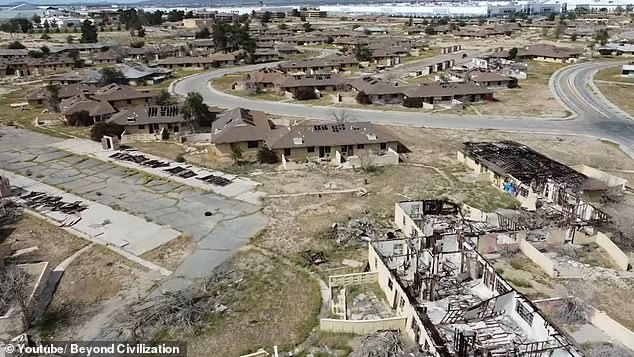The once-thriving California Air Force Base has become a ghost town 32 years after it closed amid a rampant asbestos problem and the presence of dangerous chemicals.
George Air Force Base (AFB), originally known as Victorville Army Airfield, was established in World War II to support tactical combat operations and train aircrews.
It closed permanently in December 1992, two years after the Environmental Protection Agency (EPA) considered it a Superfund site due to a surprising discovery of soil, water and air contaminants. Years later, several former residents have suffered a litany of serious health problems.
Since its closure, explorers have posted videos online touring the desolate grounds showing deteriorating homes, shops, schools and other facilities.
“The expanse of abandoned and sometimes ruined buildings, the dead landscape and years of collected brush create a very disturbing site,” said one visitor.
The once-thriving George Air Force Base (pictured) is now desolate after it closed in December 1992.

The old medical building (pictured) is covered in broken glass and graffiti.
Other images show housing complexes with shattered windows and stairs, as well as a medical building covered in broken glass.
“I’ll be honest, this place scares me a little,” said another explorer. ‘It’s just a disaster. Soil pollution is terrible. “It’s a really sad show because it has a lot of history.”
The 5,347-acre base is located approximately 70 miles northeast of Los Angeles in San Bernardino County, near the cities of Victorville and Adelanto.
During its operation, the EPA discovered that the use and disposal of hazardous and non-hazardous materials at the site was mandatory.
“At least 50 years of military aircraft operations have resulted in the release of several contaminants of potential concern (COPC) into soil and their leaching into groundwater, which could impact human health and the environment,” the agency said. .

Desolate land has destroyed homes, shops, schools and other dilapidated facilities.

Homes have been broken into with broken windows and smashed doors.
The EPA said groundwater at George Air Force Base is contaminated with jet fuel, trichlorethylene (TCE), pesticides and nitrates.
The soil is contaminated with total petroleum hydrocarbons (TPH), dioxins, construction debris, medical waste, pesticides, semi-volatile organic compounds (SVOCs), and various inorganic compounds.
More than 100,000 people were potentially exposed to hazardous levels of hazardous, toxic and radioactive materials at and around the site, according to George Air Force Base Informationa website run by a former airman who lived on the base.
Nearly 20,000 people lived in the surrounding community and 80,000 worked, lived and went to school on the base.
George AFB Info obtained a copy of a preliminary review of the base’s environmental requirements and concerns from 1993 that found that 40 percent of buildings constructed before 1980 at the site tested positive for asbestos.

The base was established in World War II to support tactical combat operations and train aircrew.

Nearly 20,000 people lived in the surrounding community and 80,000 worked, lived and went to school on the base.
In 2020, at least 51 plaintiffs attempted to sue the federal government alleging that exposure to toxic chemicals from the base caused a range of medical problems, from cancer and heart disease to miscarriages and infertility, it reported. The Orange County Register.
However, a judge dismissed their lawsuit on the grounds that the federal government has “sovereign immunity.”
In recent years, people living on the base have been speaking out about the illnesses they suffered from, and women shared stories of how officials told them not to get pregnant while living there.
Denise Torri and her husband served together at George from 1986 to 1989. She told the military times Shortly after marrying in 1987, she became pregnant but had a miscarriage.
When she went to the doctor on base, Torri said she was warned: “Don’t get pregnant.”

Pictured: An aerial photograph of the abandoned George FB houses.

Denise Torri (pictured) served at George from 1986 to 1989, was advised by officials not to become pregnant and suffered a miscarriage while living there.
“Wouldn’t you just assume it was to relax you (so you could have a successful pregnancy)?” Torri said. “You don’t think they’re really telling you, ‘Don’t get pregnant.'”
Terrine Crooks said The truth that while living on the base in 1981 she became pregnant and gave birth to her son 13 weeks early.
Her son experienced multiple brain bleeds shortly after birth and developed a number of health problems, including cerebral palsy.
Crooks said she also developed health problems that led her to undergo a hysterectomy at age 31 and a bilateral mastectomy at age 40.
When he learned that George had been named a Superfund site, he filed a claim with the Veterans Association and won in 2014. The decision stated that his medical conditions were “at least as likely as not” caused by his military service, specifically his time at the base.
“I support the military 100 percent, but I am angry and angry that they could do this to me and my family,” Crooks told the outlet. “I’m very angry, to be honest.”

